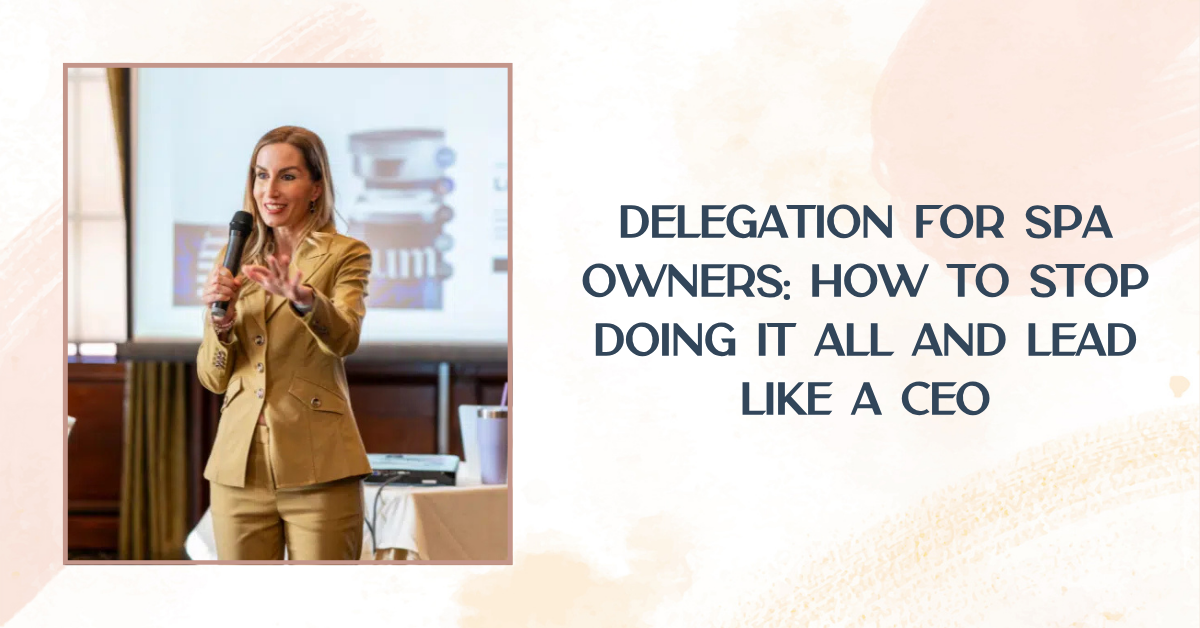If you have ever thought, “If I do not do it, it will not get done, or it will not be done right,” you are not alone. That belief keeps many spa owners stuck doing everything, from booking clients and ordering inventory to writing captions and running payroll.
This mindset becomes a bottleneck that caps your growth and drains your energy. Delegation is not lowering your standards. It elevates outcomes by enabling others to use your systems.

Your business needs your judgment and vision more than it needs your constant presence at the front desk. When you live inside day-to-day tasks, you starve the strategic thinking that grows the business. Creating space for yourself, whether that is a weekend off, a full vacation, or two hours of deep focus, unlocks the ideas and relationships that move the needle. Stop being only the operator and start being the owner.
As a Spa CEO, your highest value work includes:
- Strategic planning across 18-month horizons executed in quarterly rhythms
- Financial oversight, including budgets, pricing, and profit percentage
- Hiring and leadership for a team that can run without you
- Partnerships and community visibility, so you become the mayor of your town
- Systems design and innovation, including practical uses of AI
When you spend time building relationships in the community, you can generate referral volume that far exceeds a single day in the treatment room. A focused morning of relationship building might open doors to tens of thousands of dollars in annual referrals. That is real CEO work.
Many owners are meticulous, and that strength can turn into a ceiling. Perfectionism limits team capacity and keeps you trapped. People learn by doing, and they will miss the mark at first. Delegate with guardrails and clear outcomes rather than expecting instant perfection. Your standards stay high because the system is clear and the coaching is consistent.
CEO work to keep on your plate
- Strategic planning and quarterly execution
- Financial oversight and profitability decisions
- Final hiring decisions and leadership development
- External partnerships, public relations, and community visibility
- Driving systems and innovation, including AI adoption

Tasks to delegate with SOPs and clear metrics
- Front desk operations, including phone scheduling, confirmations, consent forms, and inventory checks. It is one of the hardest roles in a spa, and it should not be yours
- Marketing production tasks such as social scheduling, caption drafting, and basic Canva graphics
- Payroll and bookkeeping, which can be outsourced to specialists
- Inventory ordering and vendor management, which can be handled by a spa manager or trained front desk lead
- Social media replies and DMs, which can be delegated or systematized with tools and templates
With a trained front desk, a capable assistant, and purposeful use of AI, you can clear this entire list and get your time back.
We are living through an AI revolution. Leaders who implement it reduce labor hours on repetitive work and increase speed and quality. Your job as CEO is to decide where AI fits and then train your team on the workflow.
Fast AI wins to standardize
- Turn long-form content into caption drafts, email outlines, and post ideas
- Use Canva’s magic tools and brand templates for simple promotions and seasonal campaigns
- Create first pass SOPs by recording a Loom while you perform a task, then ask an AI assistant to convert the transcript into a numbered procedure that you edit to match your brand voice

Step 1: Record the gold standard
Open Loom while you do the task once. Narrate what you are doing and why it matters. Paste the transcript into an AI assistant to create a draft SOP. Keep the tool stack simple. Video plus a shared doc is enough to start.
Step 2: Assign to the right person
Hire the smile and train the skill. Match tasks to strengths and interests so people stay engaged. A friendly, organized front desk lead can be trained to own phones, scheduling confirmations, and retail support. A detail-focused assistant can manage inventory and vendor communication.
Step 3: Define success with numbers
Clarity creates confidence. Examples include answering phones by the third ring, confirming all appointments by a set time, achieving a defined conversion rate on new client inquiries, and maintaining retail inventory accuracy within a small variance. Put these metrics on a weekly scorecard and review them with the person who owns the task.

Step 4: Meet weekly and coach
Hold a short check-in to remove roadblocks, clarify the SOP, and reinforce outcomes. Recognize progress even if it is 80 percent of how you would do it. That 80 percent done by someone else gives you back the time to do 100 percent CEO work that only you can do.
Step 5: Celebrate and iterate
As the team repeats the task, the quality rises. Your role is to adjust the system and provide coaching rather than jumping back in. The discomfort you feel when you let go is normal and temporary. The payoff is long term capacity for growth.

- Monday, 90 minutes: Leadership meeting to review scorecards’ top priorities and roadblocks
- Tuesday, 2 hours: Strategic work on the offer calendar campaign map and partnerships
- Wednesday, 60 minutes: Financial review that includes a quick P and L snapshot, profit percentage, and pricing checks
- Thursday, 90 minutes: Visibility and relationship building. Schedule coffee with a local business owner, attend a Chamber Rotary, or BNI touchpoint, or reach out to a local media contact. This work drives referrals at scale
- Friday, 60 minutes: Systems and innovation time. Update SOPs, improve AI workflows and audit tools, and subscriptions
If you are still in the treatment room, reduce the number of days gradually and protect at least one of these CEO blocks each week. Consistency beats intensity.
Trap: It is faster if I do it
Fix: It may be faster this week, but it is slower this quarter. Create the Loom and the SOP once, then harvest the time saved every month thereafter.
Trap: No one does it like me
Fix: Define the outcome and the metric, not every micro step. Coach to the target and let the person follow the SOP in their own style as long as the results match the standard. Remember that perfectionism limits capacity.
Trap: Delegating without clarity
Fix: Put the SOP in writing, set deadlines and numbers, and confirm understanding in your weekly check-in. Use the scorecard to track performance so the conversation is about facts and improvement.
Trap: Taking the task back after one mistake
Fix: Expect a learning curve. Keep ownership with the team and update the SOP when a miss exposes a gap. That is how skills, confidence, and consistency grow.

- Day 1: Pick a recurring task, such as confirmations. Record a Loom while you perform it
- Day 2: Turn the transcript into an SOP draft using an AI assistant
- Day 3: Assign the task to the right person and walk through the SOP together
- Day 4: Define success metrics such as 95 percent confirmations by 2 PM and phone response by the third ring
- Day 5: Shadow once to capture questions and update the SOP
- Day 6: Let the team member run the task without you. You check only the metric
- Day 7: Celebrate wins, document lessons learned and schedule the next handoff
Repeat the sprint for one new task each week until you have removed yourself from every routine function that does not require your unique judgment.
Great spa businesses are built on systems that do not depend on the owner being present for every decision. Delegation is how you build those systems and buy back the time to do the work only you can do. When you step into CEO leadership, your team gets clarity, your clients get consistency, and your business gains capacity.
Your move today: Choose one task, record it, and hand it off. Give someone on your team the opportunity to rise and give yourself the space to lead. Delegate to elevate and claim the next level of your business and your life.

Subscribe to Our Newsletter
Stay up-to-date with our email newsletter to receive important updates, news, and offers!

About the Author
Daniela Woerner is the founder of Addo Aesthetics and creator of the Growth Factor® Framework, a proven system that’s helped hundreds of spa owners build profitable, systemized businesses. With nearly 20 years in the aesthetics industry, she transforms overworked service providers into confident Spa CEOs through strategy, systems, and soul-led support. Daniela is also the host of Spa Marketing Made Easy, a top-ranked podcast with over 1 million downloads, where she shares real-world strategies to help spa professionals grow with clarity and confidence.

